Cisco Systems 2500-PCM19-R1 PCMCIA Broadband Wireless Access card User Manual Ripwave Modem User Guide
Cisco Systems, Inc PCMCIA Broadband Wireless Access card Ripwave Modem User Guide
User guide
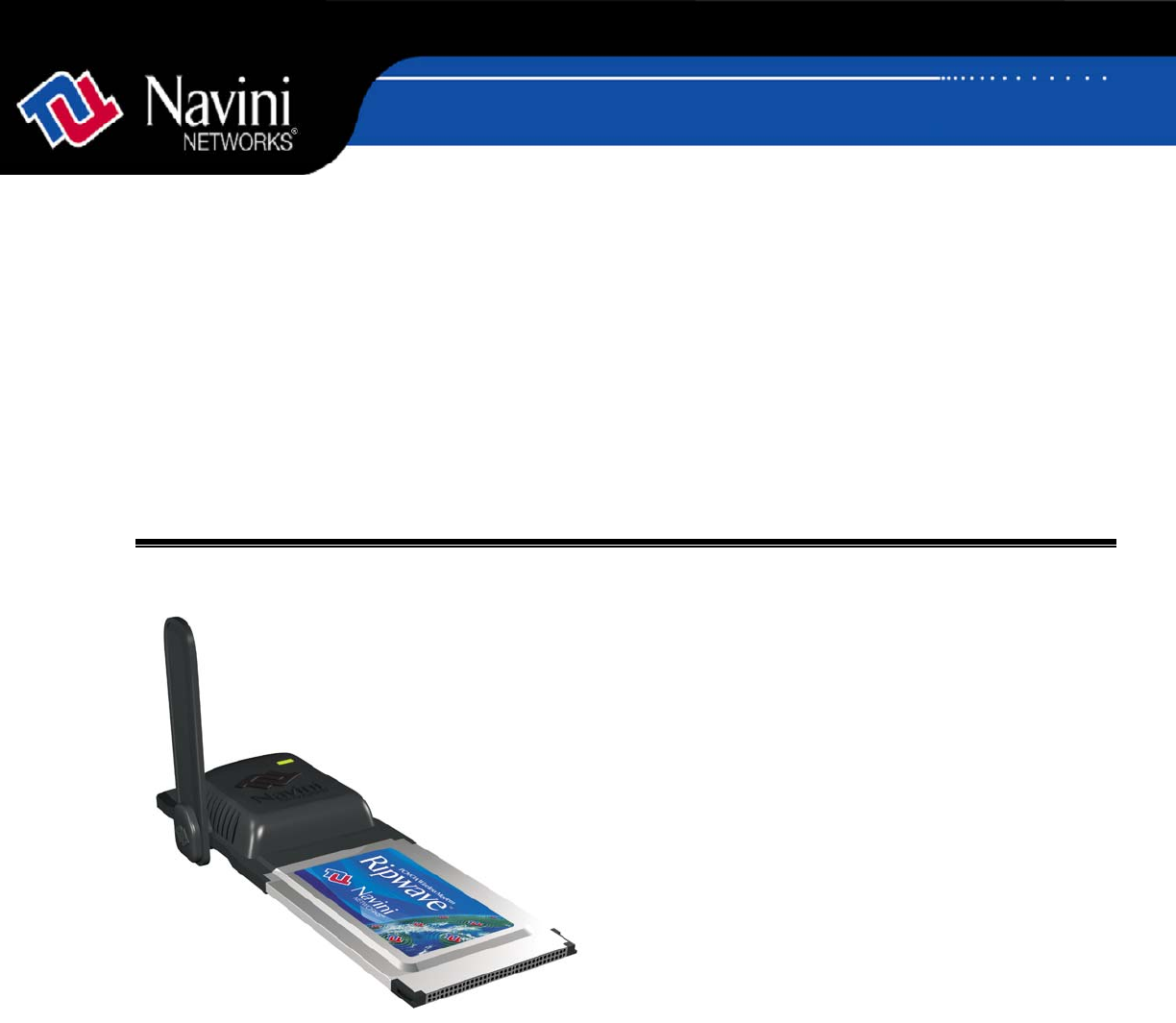
R
Ri
ip
pw
wa
av
ve
e
W
Wi
ir
re
el
le
es
ss
s
B
Br
ro
oa
ad
db
ba
an
nd
d
A
Ac
cc
ce
es
ss
s
(
(P
PC
C)
)
C
Ca
ar
rd
d
U
Us
se
er
r’
’s
s
G
Gu
ui
id
de
e
Part Number 40-00292-00
Revision A, Version 1.0, PV1.2
May 25, 2005
Proprietary
All information disclosed by this document is the proprietary property of Navini Networks, Inc. and is protected
by copyright, trademark, and/or trade secret laws. All rights therein are expressly reserved.

Navini Networks, Inc. Ripwave Wireless Broadband Access (PC) Card User’s Guide
Page 2
050525_pv1.2_PC_Card_User’s_Guide_40-00292-00b(4.3)
TABLE OF CONTENTS
PERMISSIONS, TRADEMARKS & DISTRIBUTION................................................................................................................... 3
SAFETY ........................................................................................................................................................................................ 4
REGULATORY INFORMATION.................................................................................................................................................. 5
INTRODUCTION.......................................................................................................................................6
PACKAGE INVENTORY.........................................................................................................................6
RIPWAVE MODELS.................................................................................................................................6
MINIMUM COMPUTING REQUIREMENTS......................................................................................7
PHYSICAL CHARACTERISTICS..........................................................................................................7
INSTALLING THE PC CARD ON WINDOWS 2000 ...........................................................................8
ACCESSING THE INTERNET..............................................................................................................11
DISCONNECTING THE PC CARD......................................................................................................11
INDICATOR LIGHT...............................................................................................................................13
TROUBLESHOOTING...........................................................................................................................13
INSTALLING NAVINI DIAGNOSTICS (NAVDIAG) SOFTWARE................................................13
USING NAVINI DIAGNOSTICS ...........................................................................................................18
UNINSTALLING NAVINI DIAGNOSTICS SOFTWARE.................................................................23
UPGRADING THE PC CARD................................................................................................................26
ADDENDUM 1: PC CARD - PC TROUBLESHOOTING...................................................................27
ADDENDUM 2: END USER SOFTWARE LICENSE AGREEMENT.............................................31

Navini Networks, Inc. Ripwave Wireless Broadband Access (PC) Card User’s Guide
Page 3
050525_pv1.2_PC_Card_User’s_Guide_40-00292-00b(4.3)
Permissions, Trademarks & Distribution
Copyright© 2004 - 2005, Navini Networks, Inc. All information contained herein and disclosed by this
document is confidential and the proprietary property of Navini Networks, Inc. and all rights therein are
expressly reserved. Acceptance of this material signifies agreement by the recipient that the information
contained in this document is confidential and that it will be used solely for the purposes set forth herein.
Acceptance of this material signifies agreement by the recipient that it will not be used, reproduced in
whole or in part, disclosed, distributed, or conveyed to others in any manner or by any means – graphic,
electronic, or mechanical, including photocopying, recording, taping, or information storage and retrieval
systems – without the express written permission of Navini Networks, Inc.
Navini Networks is a registered trademark. The Navini Networks logo, Zero-Install, Ripwave, and
Unwired by Navini are trademarks of Navini Networks, Inc. Other product and company names
mentioned herein may be trademarks and/or service marks of their respective owners.
Except for the hardware warranty, nothing herein constitutes any representation, warranty,
assurance, or guaranty of any kind.
Because of continuing developments and improvements in design, manufacturing, and deployment,
material in this document is subject to change without notification and does not represent any
commitment or obligation on the part of Navini Networks, Inc.
Navini Networks, Inc. shall have no liability for any error or damages resulting from the use of this
document.
All Navini Networks logos and trademarks are the property of Navini Networks, Inc. Unauthorized usage
is strictly prohibited without the express written permission of Navini Networks, Inc.
© 2004 - 2005 Navini Networks, Inc. All rights reserved.

Navini Networks, Inc. Ripwave Wireless Broadband Access (PC) Card User’s Guide
Page 4
050525_pv1.2_PC_Card_User’s_Guide_40-00292-00b(4.3)
Safety
When using a Ripwave Wireless Broadband Access Card, always follow basic safety precautions to
reduce the risk of electrical shock, fire, and injury to people and/or property. Follow all warnings and
instructions that come with the equipment.
1. Do not use the equipment while you are in a bathtub, shower, pool, or spa. Exposure of the
equipment to water could cause severe electrical shock or serious damage to the equipment.
2. Do not immerse the equipment in any type of liquid. Use a damp, lint-free cloth and if needed, an
electrical contact cleaner that is non-conductible to clean the Modem card. Unplug the Modem card
from the PC before cleaning. Do not use chemicals or abrasive to clean the Modem card. Also, use
caution around the connection pins.
3. Follow all airport and FAA regulations when using the equipment on or near aircraft.
4. Do not use the Ripwave Wireless Broadband Access Card near medical equipment, life support
equipment, or any equipment that may be susceptible to any form of radio interference. In such areas,
the Card must be powered off.
5. The driver or operator of any vehicle should not operate the Ripwave Wireless Broadband Access
Card while in control of a vehicle. Doing so will detract from the driver or operator’s control and
operation of the vehicle.
6. Do not disassemble the equipment. Removing covers may expose dangerous voltages or other risks
and also voids the warranty. Incorrect reassembly can cause equipment damage or electrical shock.
Only an authorized repair technician should service this product.
7. Do not expose the equipment to extreme hot or cold temperatures.
8. Do not use the equipment under the following conditions:
• When the equipment has been exposed to water or moisture.
• When the equipment has been damaged.
• When the equipment does not operate properly or shows a distinct change in performance.

Navini Networks, Inc. Ripwave Wireless Broadband Access (PC) Card User’s Guide
Page 5
050525_pv1.2_PC_Card_User’s_Guide_40-00292-00b(4.3)
Regulatory Information
This Ripwave Wireless Broadband Access Card has been tested with a typical laptop computer with a
side loading PCMCIA bay. This PC Card must not be co-located or operated in conjunction with any
antenna (other than the one furnished by Navini and included in the package) or transmitter. Use of this
device in any other configuration may exceed the FCC, ETSI, or other regulatory bodies RF Exposure
compliance limit.
These limits are designed to provide reasonable protection against harmful interference in a residential
installation. This equipment generates, uses, and can radiate radio frequency energy and, if not installed
or used in accordance with the instructions, may cause harmful interference to radio communications.
However, there is no guarantee that interference will not occur in a particular installation. If this
equipment does cause harmful interference to radio or television reception, which can be determined by
turning the equipment off and on, the user is encouraged to try to correct the interference by one or more
of the following measures:
1) Reorient or relocate the receiving antenna,
2) Increase the separation between the equipment and the receiver,
3) Consult the dealer or an experienced radio technician for additional suggestions.
FCC guidelines stipulate that the antenna should be more than 2.5 cm (1”) from bystanders and 1.0 cm
(0.39”) from the user. When in use, the antenna should be pointed vertically upward. When using the
Remote Desktop Antenna with the PC Card, a minimum distance of 20 centimeters (8 inches) is required
from the user or bystander.
SAR, or Specific Absorption Rate, is the measurement for the rate at which electromagnetic energy is
absorbed by the human body during exposure. The FCC states the body SAR limit be: 1.6 W/kg. The
highest reported SAR value for the PC card is 1.01 W/kg.

Navini Networks, Inc. Ripwave Wireless Broadband Access Card User’s Guide
Page 6
050525_pv1.2_PC_Card_User’s_Guide_40-00292-00b(4.3)
Introduction
Package
Inventory
Ripwave Models
Congratulations! The Ripwave Wireless Broadband Access Card,
or PC Card for short, is a user-friendly, easy-to-install device that
helps you connect wirelessly to the Internet using the Network
Interface Card (NIC) port on a laptop computer. It provides
complete broadband Internet access to residential and small
office/home office (SOHO) users without the necessity of
professional hardware installation.
The PC Card allows you to have portable Internet or other wireless
access service. A computer with this device can be moved from
room to room, location to location, or even city to city as long as
there is coverage and appropriate reception in the area.
Please verify the contents of your PC Card package. If you do not
find all of these items in your package, notify the supplier from
whom you obtained the package.
• The Ripwave Wireless Broadband Access Card
• External antenna
• Installation CD containing:
- PC driver software
- Navini Diagnostics application
- User’s Guide
• Printed copy of the Quick Installation Guide
Your PC Card operates in one of the following frequency ranges:
2.5-2.6, 3.4, or 3.5 GHz. The frequency number appears on the
Card’s label.
Operating Frequencies:
Model Frequency Range Operating Band
2.5-2.6 GHz 2.500 GHz - 2.686 GHz MMDS/ITFS
3.4 GHz 3.410 Ghz – 3.525 GHz WLL
3.5 GHz 3.475 GHz – 3.600 GHz WLL
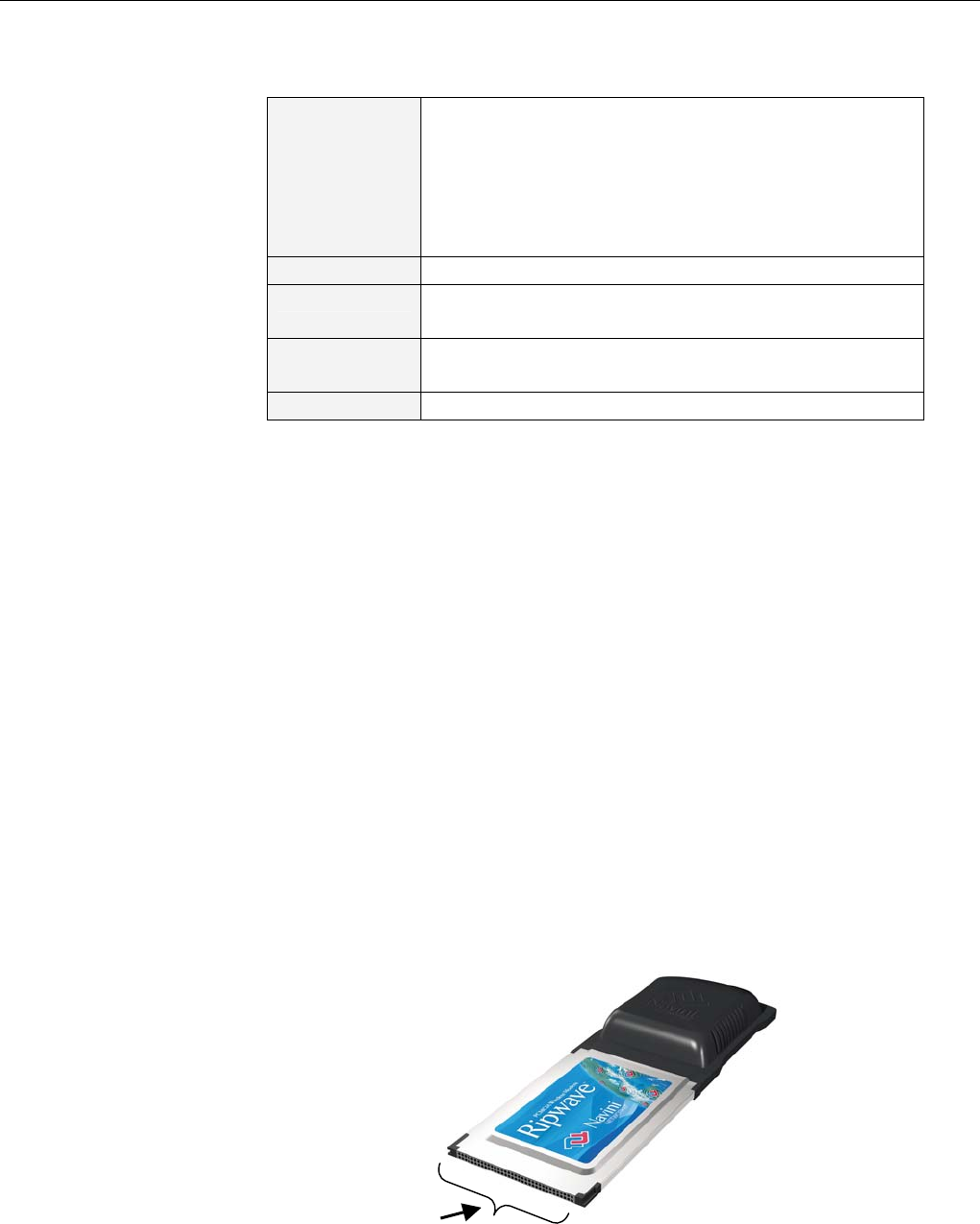
Navini Networks, Inc. Ripwave Wireless Broadband Access Card User’s Guide
Page 7
050525_pv1.2_PC_Card_User’s_Guide_40-00292-00b(4.3)
Minimum
Computing
Requirements
(See, also, Addendum 1)
Physical
Characteristics
Operating
System1: Windows 98SE, Windows 2000, Windows ME, or
Windows XP. It is assumed the latest Windows
service pack is installed on the Operating System.
Note: The PC Card is not supported on MacIntosh
systems or Linux/Unix systems.
CPU: Pentium level or higher
RAM: 32 MB or the Operating System minimum,
whichever is greater
Hard Drive: 50 MB free disk space for the optional Navini
Diagnostics software
Monitor: 256 colors, 800 x 600 resolution
NOTE1: If you are going to upgrade your Operating System after loading the
Navini Diagnostics software, you must first uninstall Navini Diagnostics prior to
upgrading the OS. Otherwise, the Wireless Modem Card will continue to
operate, but the Navini Diagnostics will not work. See Uninstall instructions in
this Guide.
This manual will guide you through the simple process of installing
the PC Card and driver software, which have been developed to
optimize the ease and convenience for you, our valued customer.
If you experience any difficulties with your card, refer to the
Troubleshooting sections of this guide. If further assistance is
needed, please contact your Service Provider or the vendor from
whom you obtained your PC Card.
The PC Card fits into a standard Type II PC network interface card
(NIC) slot. A 68-pin connector resides on the end of the card that is
inserted into the slot.
PC Card
68-pin connector
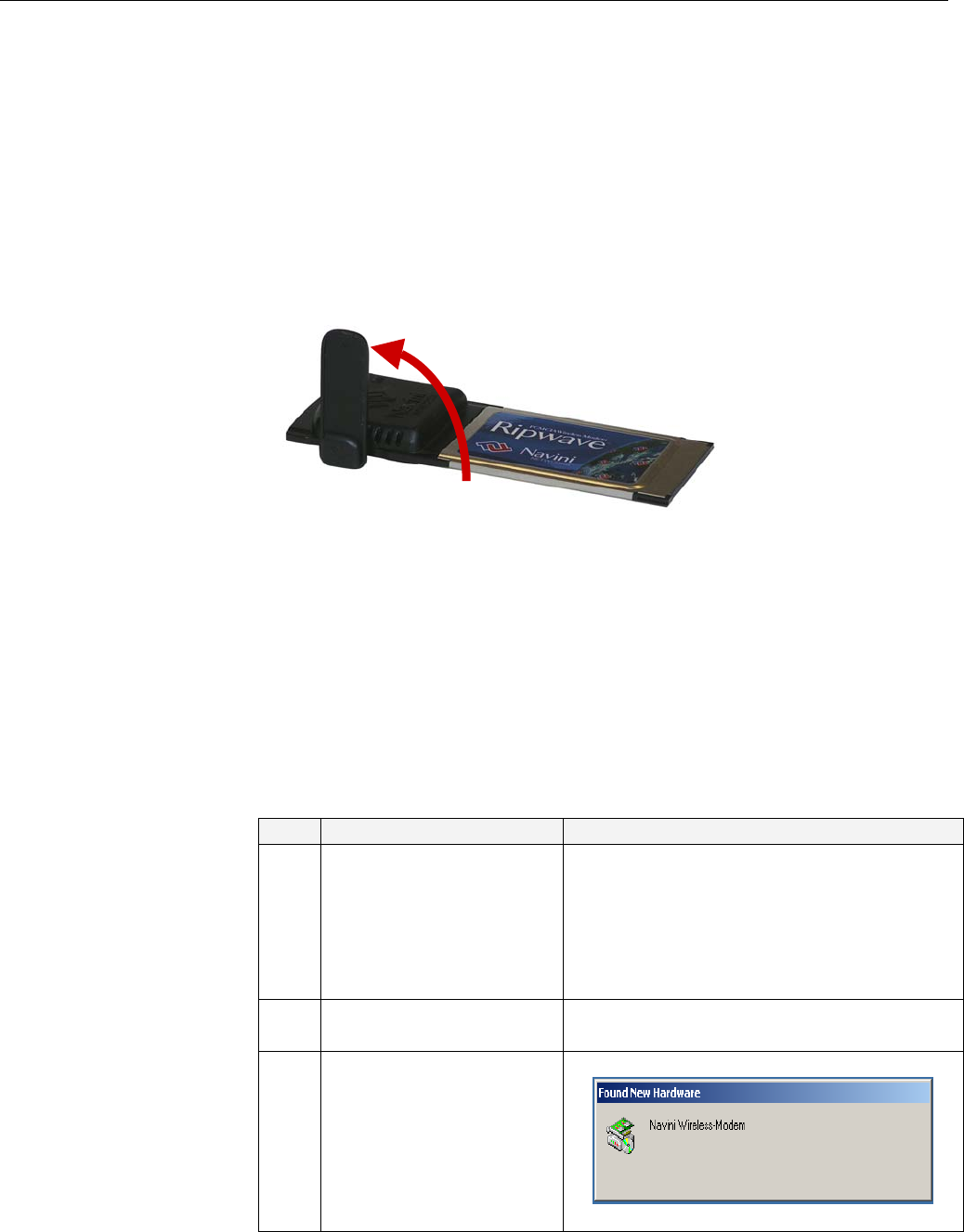
Navini Networks, Inc. Ripwave Wireless Broadband Access Card User’s Guide
Page 8
050525_pv1.2_PC_Card_User’s_Guide_40-00292-00b(4.3)
Physical
Characteristics,
continued
Installing the PC
Card on
Windows 2000
Depending on which model you have, one or two internal inverted-
F antennas reside inside the card. The 2.5-2.6 GHz model has one
internal inverted F antenna while the 3.4 and 3.5 GHz models have
two internal inverted F antennas. There is also an external antenna.
Following is a picture of the external antenna in the upright
position. To raise the antenna to its upright position, raise the
antenna counterclockwise. Do not turn the antenna beyond its
upright position.
The following instructions explain how to install a PC Card and its
driver software. Please read all instructions before attempting the
installation.
Note: The screenshots shown in these instructions were taken from
a laptop operating with Windows 2000. If you have a Windows 98,
XP, or ME operating system, the screens you see may vary from
the screens shown in the instructions.
Step Action Illustration
1. Insert the card into the
Type II card slot on your
computer. Be sure to
insert the end that has
the 68-pin connector
into the card slot.
2. Raise the antenna to the
upright position.
3. The Found New
Hardware box appears
indicating the PC sees
the PC Card.
Windows 2000 Screen
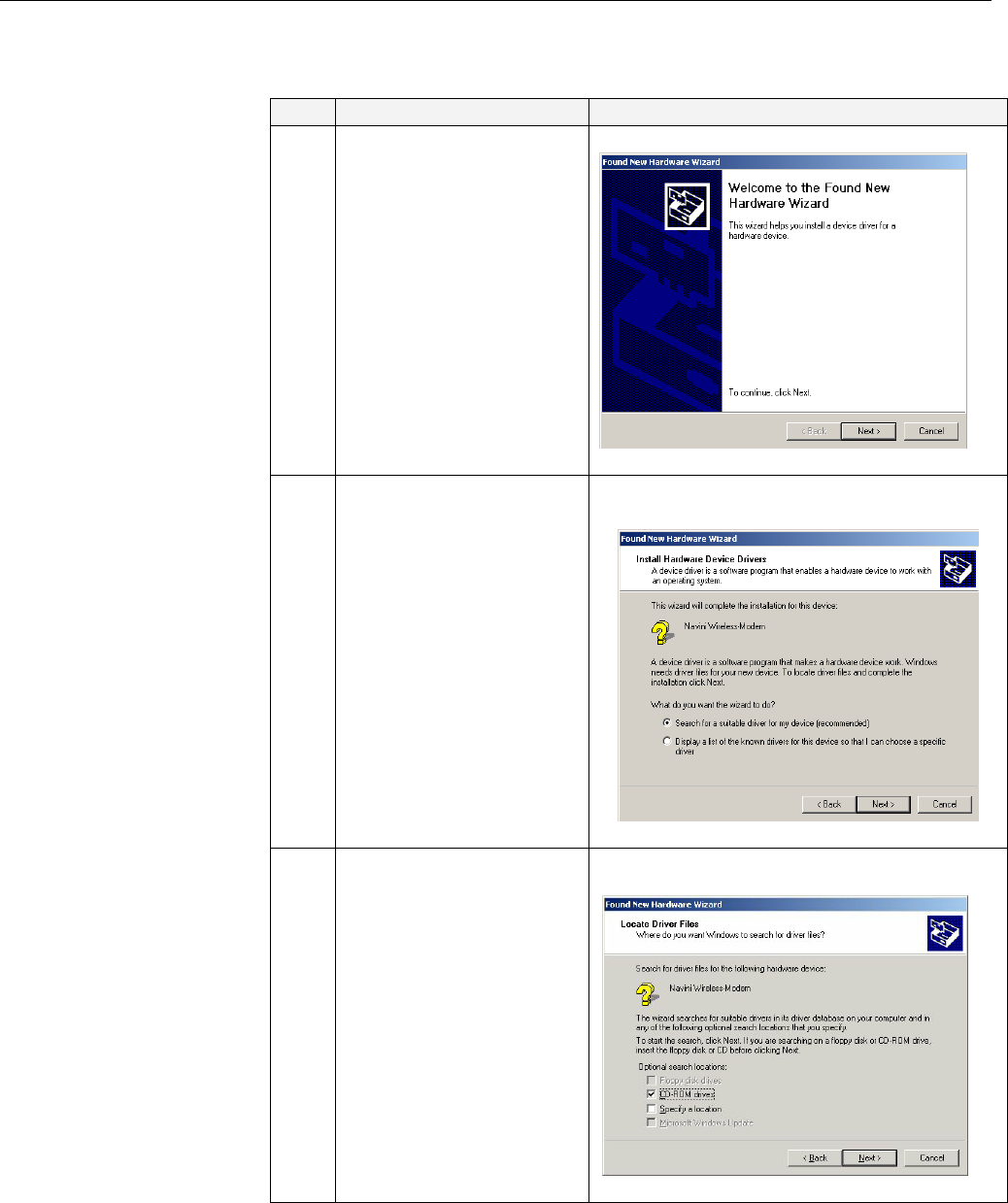
Navini Networks, Inc. Ripwave Wireless Broadband Access Card User’s Guide
Page 9
050525_pv1.2_PC_Card_User’s_Guide_40-00292-00b(4.3)
Installing the PC Card,
continued
Step Action Illustration
4. The Welcome to the
Found New Hardware
Wizard dialog box
appears. Click Next to
continue.
Windows 2000 Screen
5. The Install Hardware
Device Drivers box
appears. Select ‘Search
for a suitable driver for
my device
(recommended).’ Click
Next to continue.
Windows 2000 Screen
6. The Locate Driver Files
box appears. Select ‘CD
ROM.’ Insert the
Installation CD into the
computer’s CD-ROM
drive. Click Next to
continue.
Windows 2000 Screen
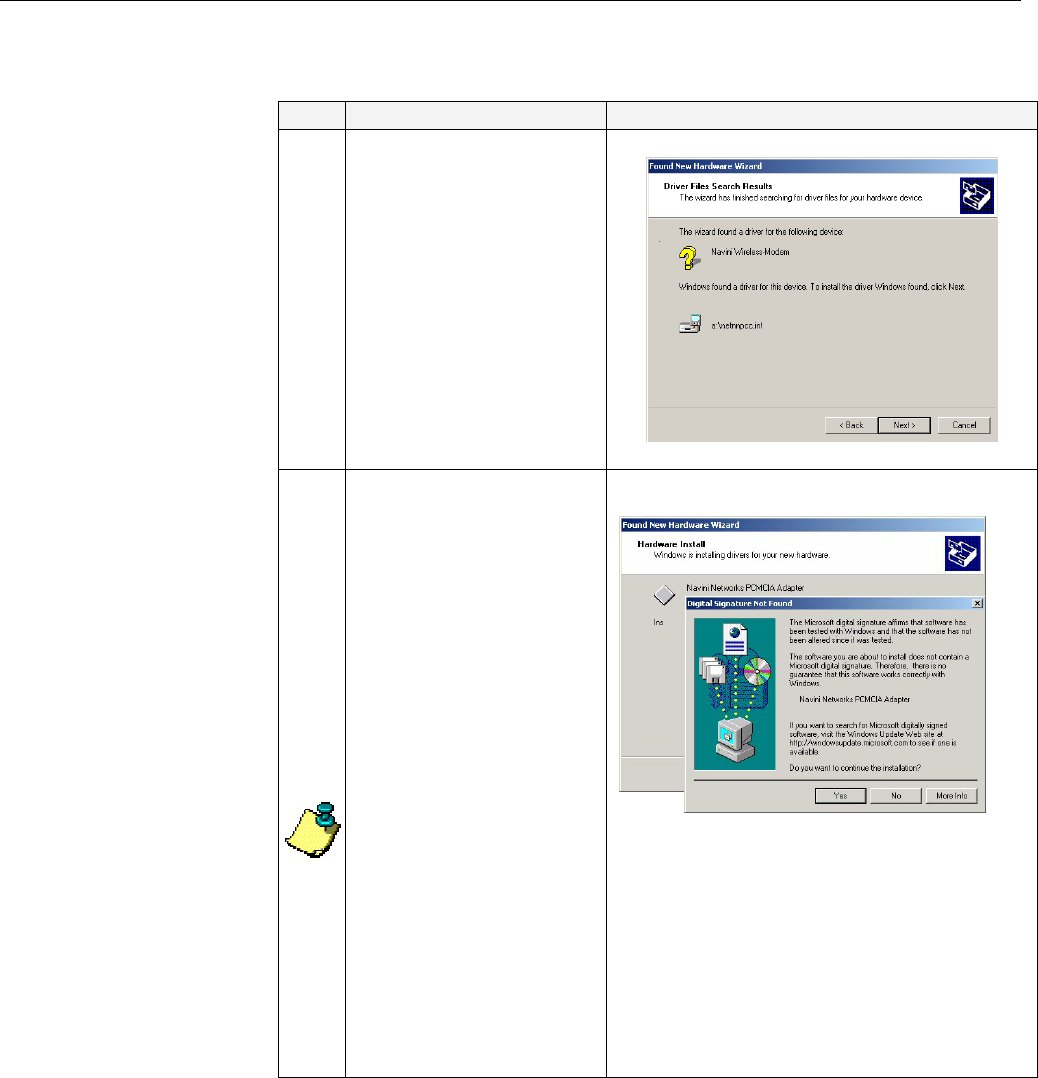
Navini Networks, Inc. Ripwave Wireless Broadband Access Card User’s Guide
Page 10
050525_pv1.2_PC_Card_User’s_Guide_40-00292-00b(4.3)
Installing the PC Card,
continued
Step Action Illustration
7.
The Driver Files Search
Results box appears.
Click Next to install the
driver.
Windows 2000 Screen
8.
The Hardware Install
box appears, along with
a Digital Signature Not
Found box. Click Yes
on the Digital Signature
Not Found box, and then
click Yes on the
Hardware Install box. If
the sound is turned up
on your computer, two
beeps are heard.
Note: Windows 98, XP,
or ME systems may
show a screen stating the
PCMCIA Adapter* has
not passed Windows
Logo testing and asking
if you want to continue
installation. Select the
option that continues the
installation.
Windows 2000 Screen
*PCMCIA is a generic name for any NIC type device.
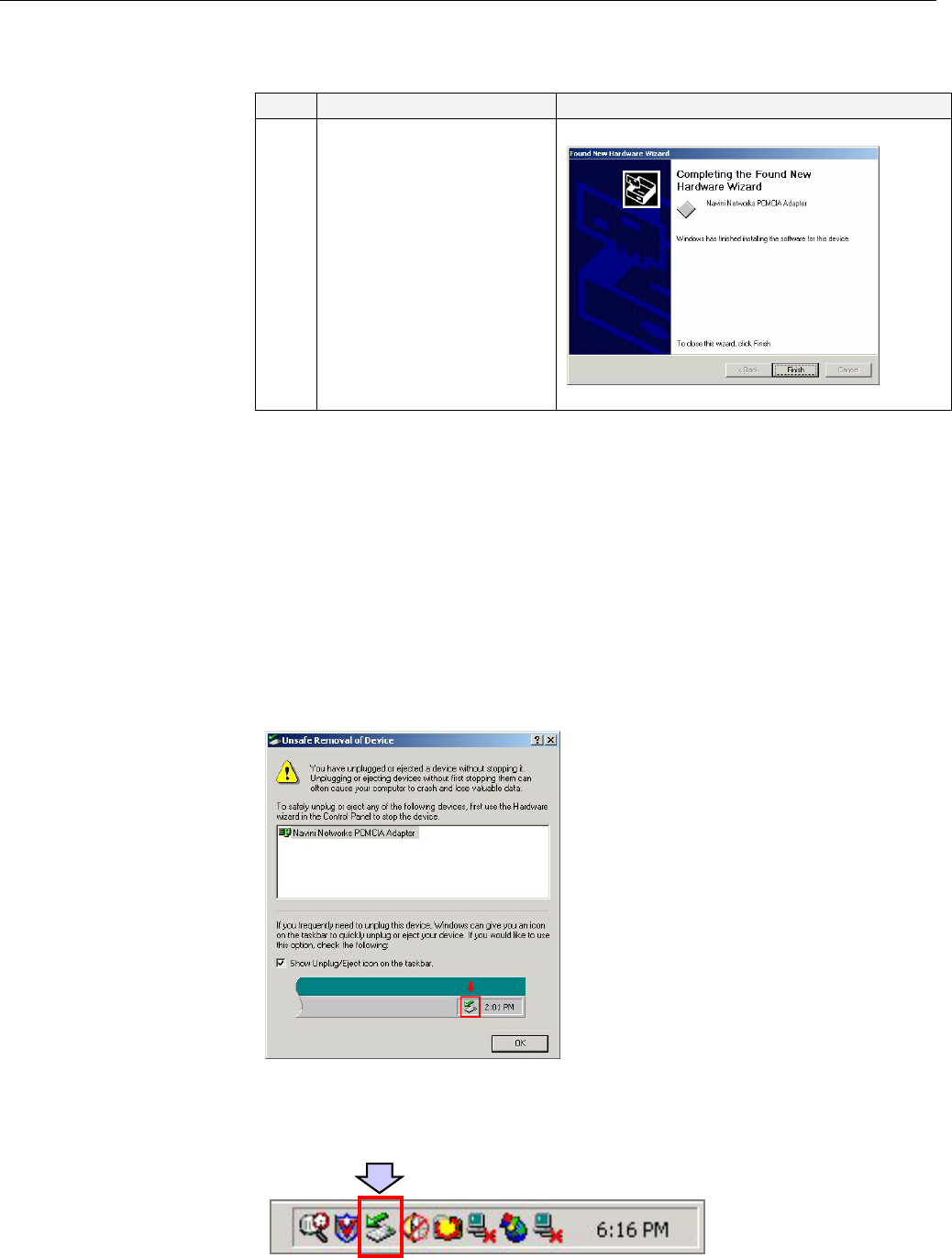
Navini Networks, Inc. Ripwave Wireless Broadband Access Card User’s Guide
Page 11
050525_pv1.2_PC_Card_User’s_Guide_40-00292-00b(4.3)
Installing the PC Card,
continued
Accessing the
Internet
Disconnecting
the PC Card
Step Action Illustration (using LED Modem)
9. After the files are
copied, a Completing
the Found New
Hardware Wizard box
appears indicating the
driver installation is
complete. Click Finish
to close the Wizard.
Windows 2000 Screen
Assuming you have service from a Service Provider, you should be
able to surf the Internet once your PC Card is installed, and the
computer is powered on! To access the Internet, open the web
browser that is installed on your computer, i.e., Netscape, Internet
Explorer, etc.
Before you pull the PC Card out of the computer card slot, you
must first stop the driver software. If you do not stop the driver
software first, the following box will appear:
To safely disconnect the PC Card, click on the Card icon indicated
in the following illustration. This icon is located in the lower right-
hand corner of the computer.
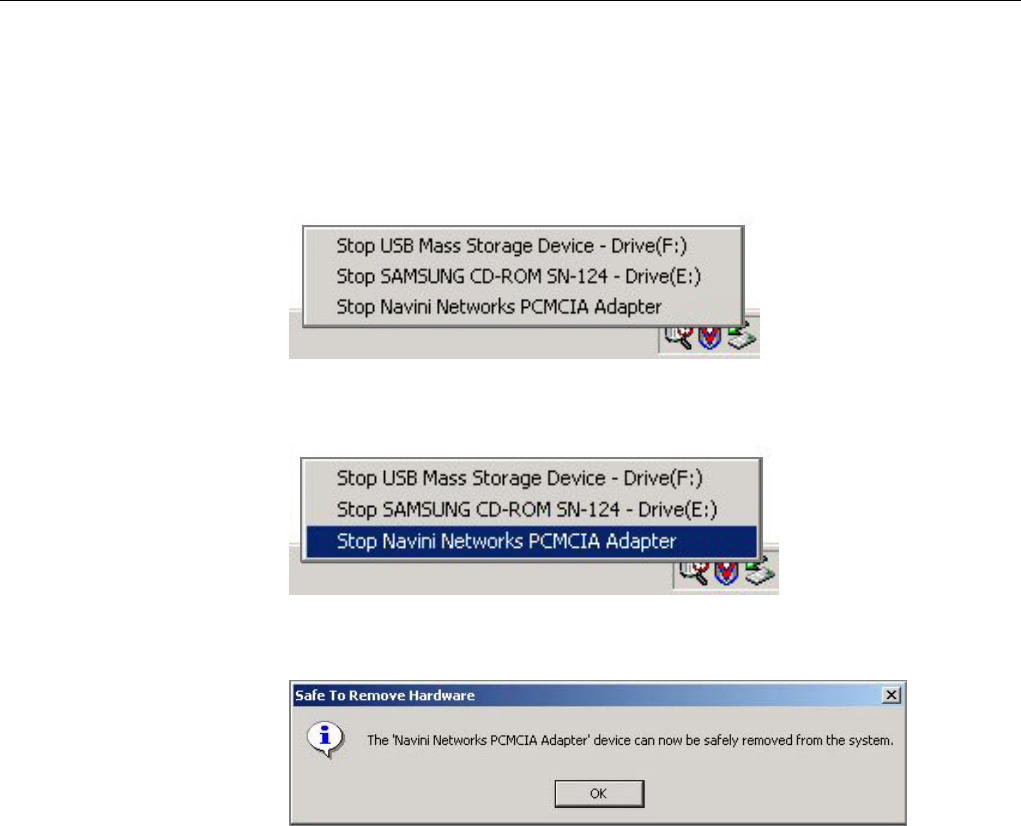
Navini Networks, Inc. Ripwave Wireless Broadband Access Card User’s Guide
Page 12
050525_pv1.2_PC_Card_User’s_Guide_40-00292-00b(4.3)
Disconnecting the PC
Card, continued
Once you click on the icon indicated, a list with one or more
elements will appear. This list is dependent on the devices
currently installed on the PC. For example:
Select Stop Navini Networks PCMCIA Adapter.
Next, the Stop a Hardware Device dialog box appears. Click OK.
You can now unplug the Card. The computer will beep indicating
the Card was unplugged. If the sound on your computer is turned
on you will hear one beep.
Note: Remove the PC Card from the PC before storing the PC in a
computer case. Also, turn the antenna to its original down position.
Leaving the card in the PC or the antenna in the upright position
while storing the PC in a computer case may damage the card or
the antenna.
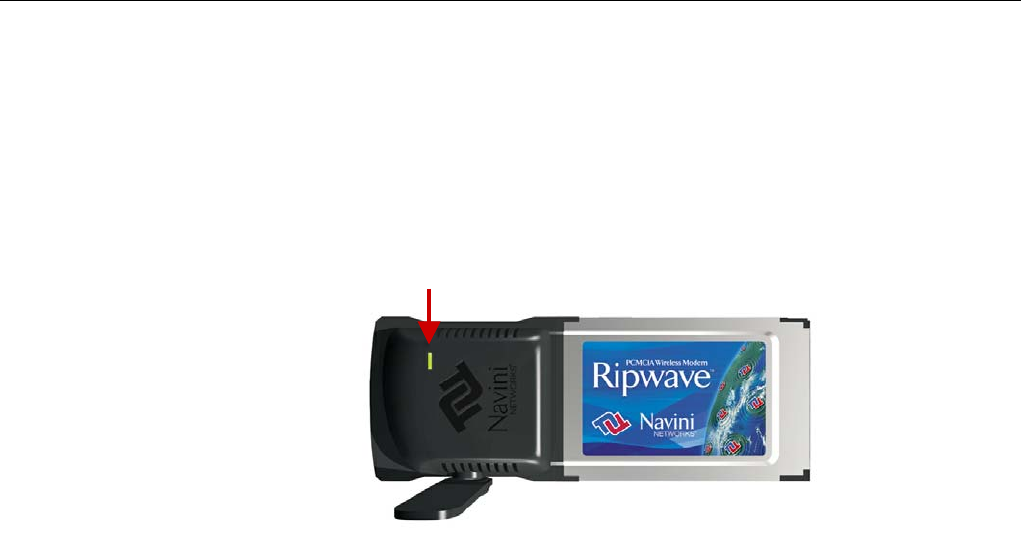
Navini Networks, Inc. Ripwave Wireless Broadband Access Card User’s Guide
Page 13
050525_pv1.2_PC_Card_User’s_Guide_40-00292-00b(4.3)
Indicator Light
Troubleshooting
Installing Navini
Diagnostics
(NavDiag)
Software
An indicator light on the top of the PC Card’s black encasement
provides information about the Card’s operation. When the light is
solid, the Card is trying to synchronize with a BTS. When the light
blinks, the Card has acquired synchronization with a Base Station.
If you experience difficulties with your Internet connection after
you have installed the PC Card driver software, please review the
Minimum Computing Requirements and Addendum 1 in this User
Guide to ensure your computer meets those requirements. Next, go
back over the installation procedures and ensure all steps were
completed properly.
Assuming the computer requirements are met and the installation
steps were completed as required, you may need to install the
Navini Diagnostics software. The Navini Diagnostics software
assists in solving connection problems. This software is provided
on the Installation CD that came in your PC Card package.
The Navini Diagnostics software enables you to troubleshoot
signal issues, network connections, and power problems. Two
important types of information it provides are signal strength and
quality of the incoming signal. It can also provide information
about the connectivity to the Service Provider’s network.
Before you install your NavDiag software, please note:
For Windows 2000 you must be logged into an account having
Administrative privileges in order to install the Navini Diagnostics
software. For Windows 98SE Operating Systems (OS), the
Windows OS CD may be required to complete the installation. If
prompted, insert the OS CD into the drive and accept the defaults.
Indicator Light
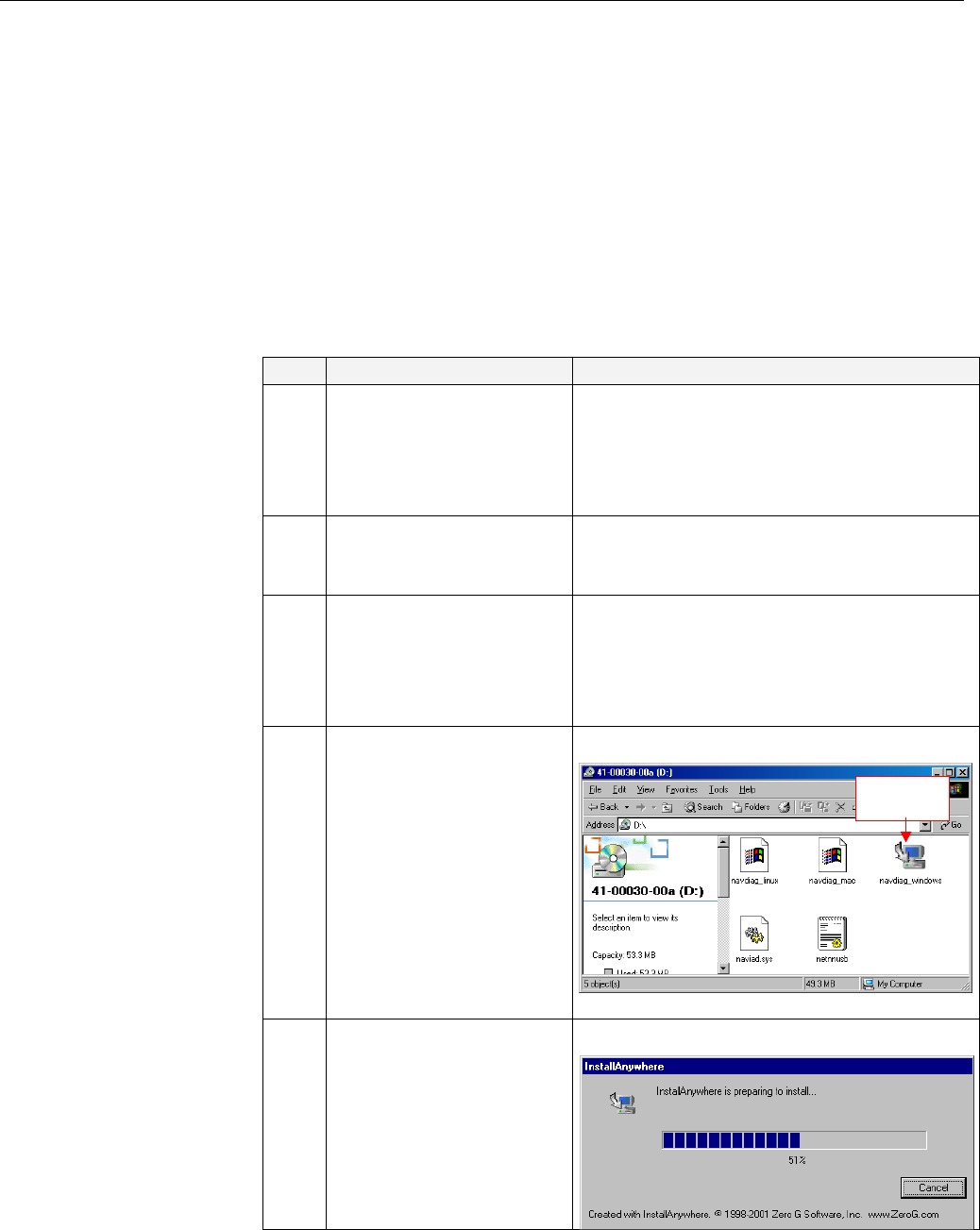
Navini Networks, Inc. Ripwave Wireless Broadband Access Card User’s Guide
Page 14
050525_pv1.2_PC_Card_User’s_Guide_40-00292-00b(4.3)
Installing Navini
Diagnostics (NavDiag)
Software, continued
If you are going to upgrade your PC Operating System after
loading the Navini Diagnostics software, you must first uninstall
NavDiag prior to upgrading the OS. Otherwise, NavDiag will not
work. See Uninstall instructions in this Guide.
Note: The screenshots shown in these instructions were taken from
a laptop with Windows 2000. If you have a Windows 98, XP, or
ME operating system, the screens you see may vary from the
screens shown in the instructions.
• Step Action Illustration
1. Shut down all programs,
including anti-virus
software programs,
before installing the
NavDiag software.
2. Insert the Installation
CD into the CD-ROM
drive.
3. Open the CD by clicking
on the My Computer
icon. Double-click on
the folder named
Navini_Diagnostics.
4. Double-click on the icon
for the file
navdiag_windows.exe*.
This will automatically
start the installation of
NavDiag.
Example
5. The InstallAnywhere
window appears. The
progress bar indicates
that InstallAnywhere has
initialized.
Windows 2000 Screen
Doubleclick
this file.
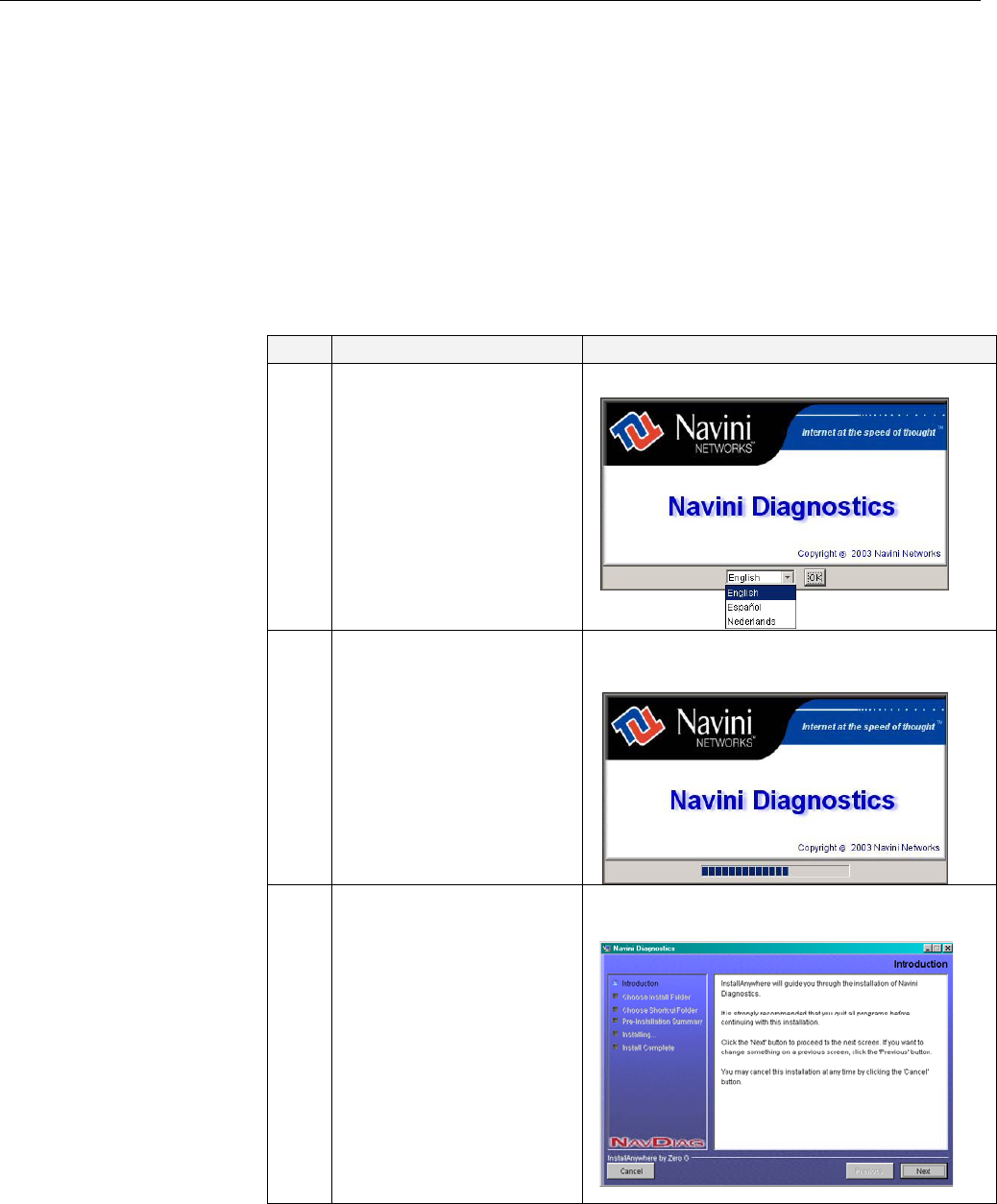
Navini Networks, Inc. Ripwave Wireless Broadband Access Card User’s Guide
Page 15
050525_pv1.2_PC_Card_User’s_Guide_40-00292-00b(4.3)
Installing Navini
Diagnostics (NavDiag)
Software, continued
*NOTE: In step 6, your version of NavDiag may automatically
attempt to match the language set on your PC under Regional
Options. The language selection affects how NavDiag displays its
screens. If you receive an error message concerning the language,
click OK and NavDiag will default to English. At this time,
NavDiag supports three languages: 1. English (U.S.), 2.Spanish
(Spain), and 3. Dutch (Holland).
Step Action Illustration
6. The Navini Diagnostics
Language screen
appears* (see Note
above). Select a
language, and click OK
to continue.
Windows 2000 Screen
7. The progress bar
indicates the files are
being installed.
Windows 2000 Screen
8. The NavDiag
Introduction screen
appears. Click Next to
continue.
Windows 2000 Screen

Navini Networks, Inc. Ripwave Wireless Broadband Access Card User’s Guide
Page 16
050525_pv1.2_PC_Card_User’s_Guide_40-00292-00b(4.3)
Installing Navini
Diagnostics (NavDiag)
Software, continued
Step Action Illustration
9. The License Agreement
screen appears. Read the
Licensing Agreement.
Select the I Accept
option, and click Next to
continue.
If the License
Agreement is not
accepted, you cannot
install the software.
Windows 2000 Screen
10. The Choose Install
Folder screen appears.
Enter the name of the
folder where you wish to
install the software.
Click Next to continue.
The default installation
folder provided by the
software is shown in the
illustration.
Windows 2000 Screen
11. The Choose Shortcut
Folder screen appears.
Accept the default and
click Next to continue.
Windows 2000 Screen
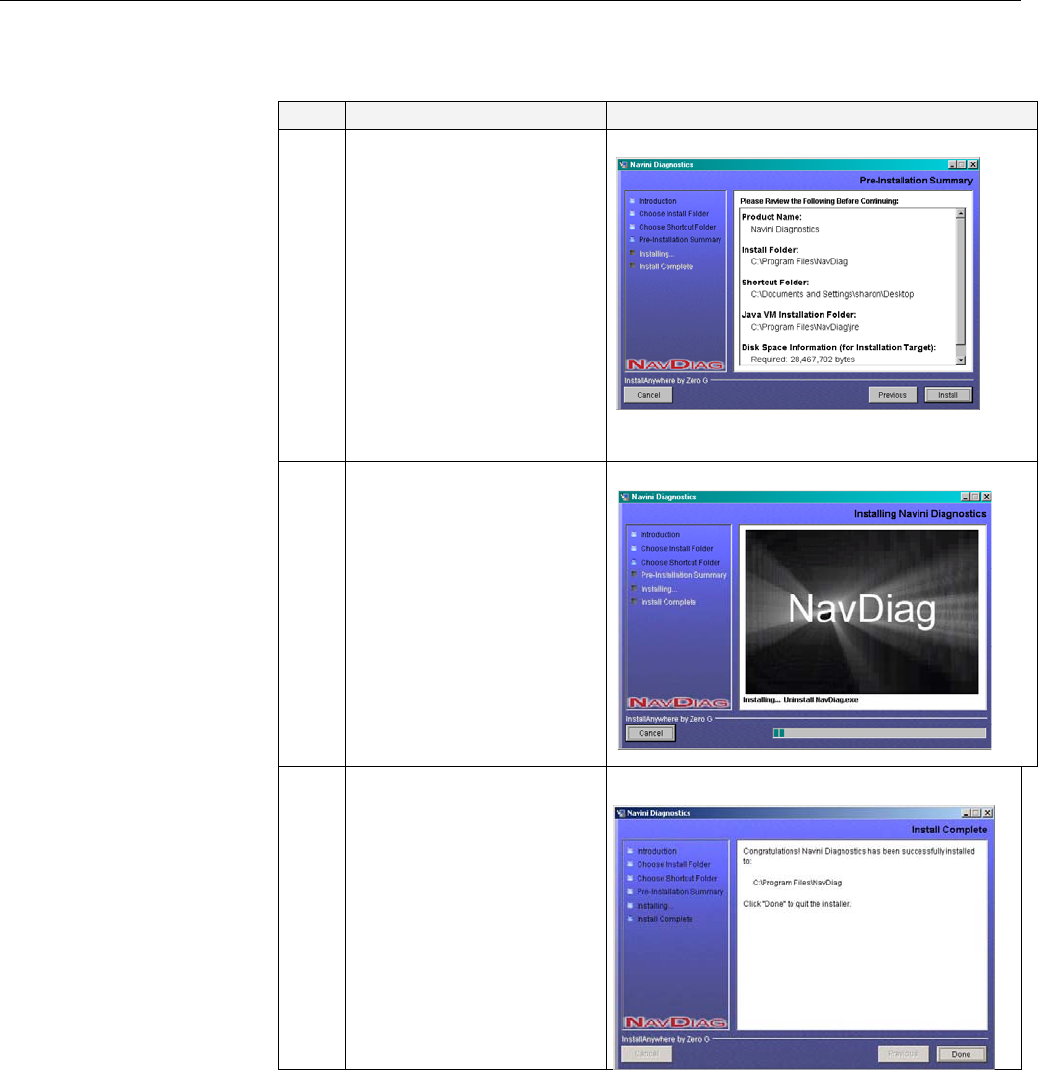
Navini Networks, Inc. Ripwave Wireless Broadband Access Card User’s Guide
Page 17
050525_pv1.2_PC_Card_User’s_Guide_40-00292-00b(4.3)
Installing the Navini
Diagnostics (NavDiag)
Software, continued
Step Action Illustration
12. The Pre-Installation
Summary screen
appears. Review the
contents for accuracy.
Click Install to
continue.
For your installation and
computer, this screen
may have different
information than what is
shown in the illustration.
Windows 2000 Screen
13. The Installing screen
will change as the
application files are
loaded.
Windows 2000 Screen
14. At the Install Complete
screen, click Done to
close the window.
Windows 2000 Screen

Navini Networks, Inc. Ripwave Wireless Broadband Access Card User’s Guide
Page 18
050525_pv1.2_PC_Card_User’s_Guide_40-00292-00b(4.3)
Using Navini
Diagnostics
To open the Navini Diagnostics software application, double-click
on the Navini Diagnostics icon on your desktop.
Navini Diagnostics.lnk
The Connection Status screen will open and display data if the
Card is in use. The screen will refresh live data every second.
Looking from left to right, the icons represent the PC, the
connection between the PC and the PC Card or Desktop Modem
(pictured), the PC Card or Modem, the connection between the
Card and the Base Station, and the Base Station with which the
Card is communicating. Check marks over the connections indicate
working connections.
If the connection between the PC and the Card or between the Card
and the Base Station is interrupted, an “X” is positioned over the
corresponding icon.
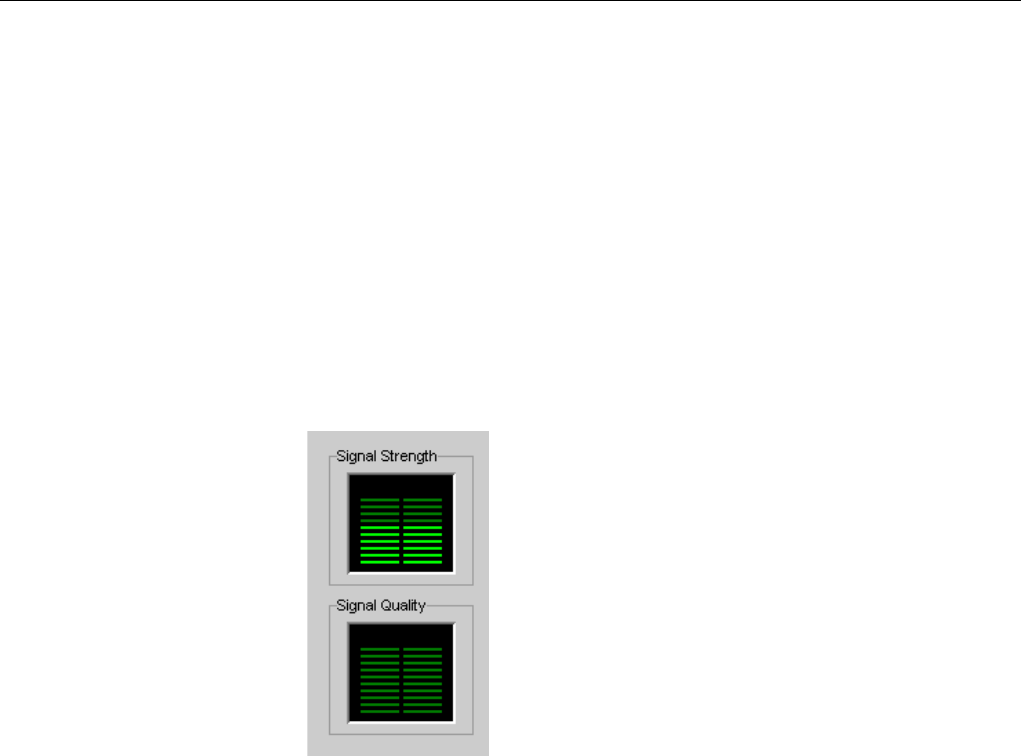
Navini Networks, Inc. Ripwave Wireless Broadband Access Card User’s Guide
Page 19
050525_pv1.2_PC_Card_User’s_Guide_40-00292-00b(4.3)
Using Navini Diagnostics,
continued
The Signal Strength and Signal Quality are dynamic bar areas that
indicate how well your PC Card is receiving signals from the Base
Station. In particular, the Signal Strength bar area graphically
represents the strength of the Absolute BTS Synchronization
Signal received by the PC Card.
The strength of the signal is represented by a group of colored bars.
The higher the pile of bars goes, the stronger the signal. The color
of the bars also gives an indication of the strength of the signal.
Green lines indicate an excellent signal. Orange lines indicate a
good signal, while red lines indicate a weak signal.
The Signal Quality bar area graphically represents the Signal-to-
Noise Ratio (SNR) of the downlink access code channel (ACC)
received by the PC Card. Again, the quality of the signal is
represented by a group of colored bars. The higher the pile of bars
goes, the better the SNR of the signal. The color of the bars also
gives an indication of the quality of the signal. Green lines indicate
high quality signal. Orange lines indicate a good quality signal
while red lines indicate a low quality signal.
To increase the strength and quality of the signal, change the
location of the PC in which the PC Card is inserted. Try moving it
closer to a window, to a higher location, away from other wireless
devices (microwave ovens, cordless phones), and away from metal
objects (shelves, file cabinets). As the PC is repositioned, observe
the Signal Strength and Quality bars. Position the Card for
maximum signal strength and quality.
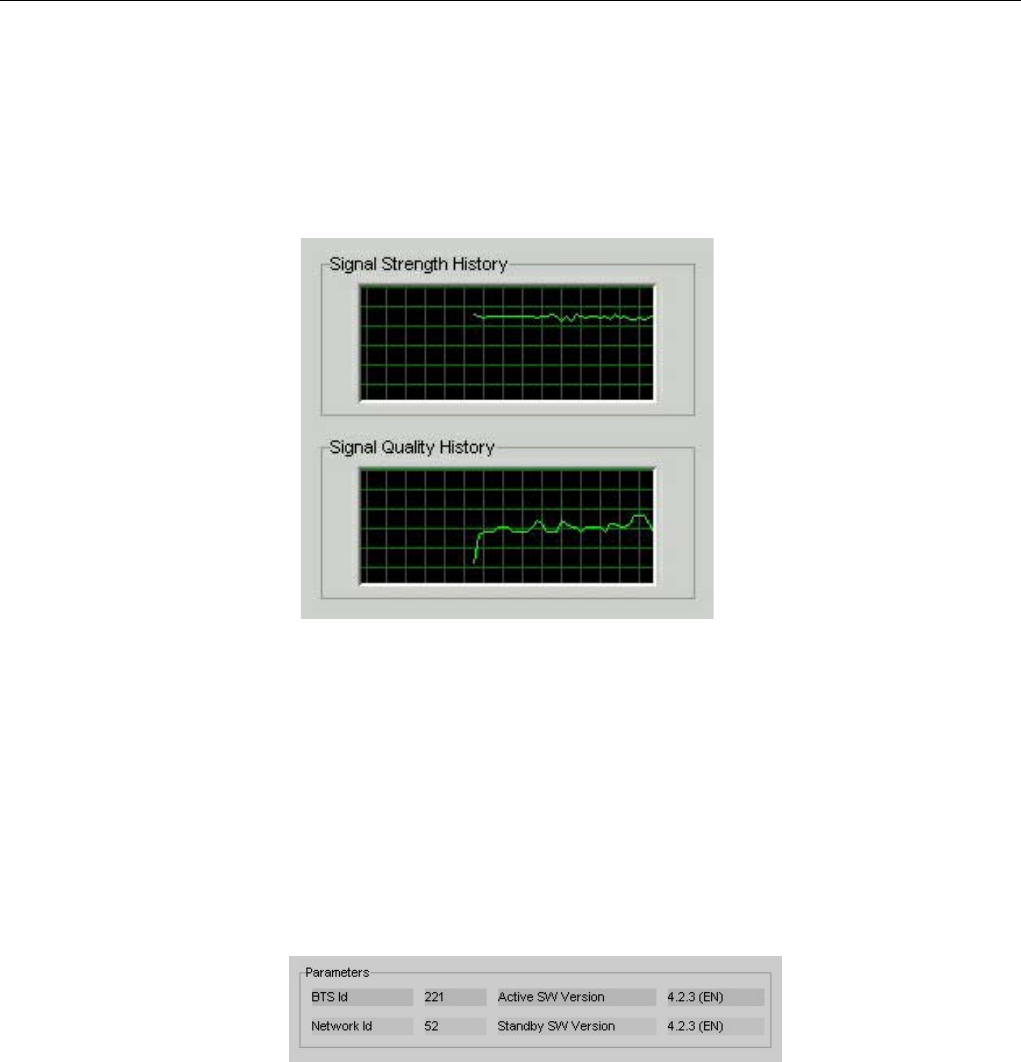
Navini Networks, Inc. Ripwave Wireless Broadband Access Card User’s Guide
Page 20
050525_pv1.2_PC_Card_User’s_Guide_40-00292-00b(4.3)
Using Navini Diagnostics,
continued
The History graphs plot the change in signal strength and signal
quality over time. The graphs cover the last minute and are updated
every second. Read the graphs from right to left. The right side of
the graph represents the most recent status of your PC Card.
At the bottom of the Connection Status screen are four parameters.
These parameters are BTS ID, Network ID, Active SW Version,
and Standby SW Version. The BTS ID and Network ID indicate
the BTS to which the PC Card is currently synchronized and the
network in which the PC Card is operating. Active SW Version
and Standby SW Version indicate the version number of the
software currently loaded in the “active side” and “standby side” of
the PC Card’s flash memory. The two letters in parenthesis
following the release number indicate the type of software load. JD
indicates Joint Detection while EN indicates Enhanced Nulling.
On the left-hand side of the screen are five screen options:
Connection Status
Configuration
Trend Analysis
Statistics
About
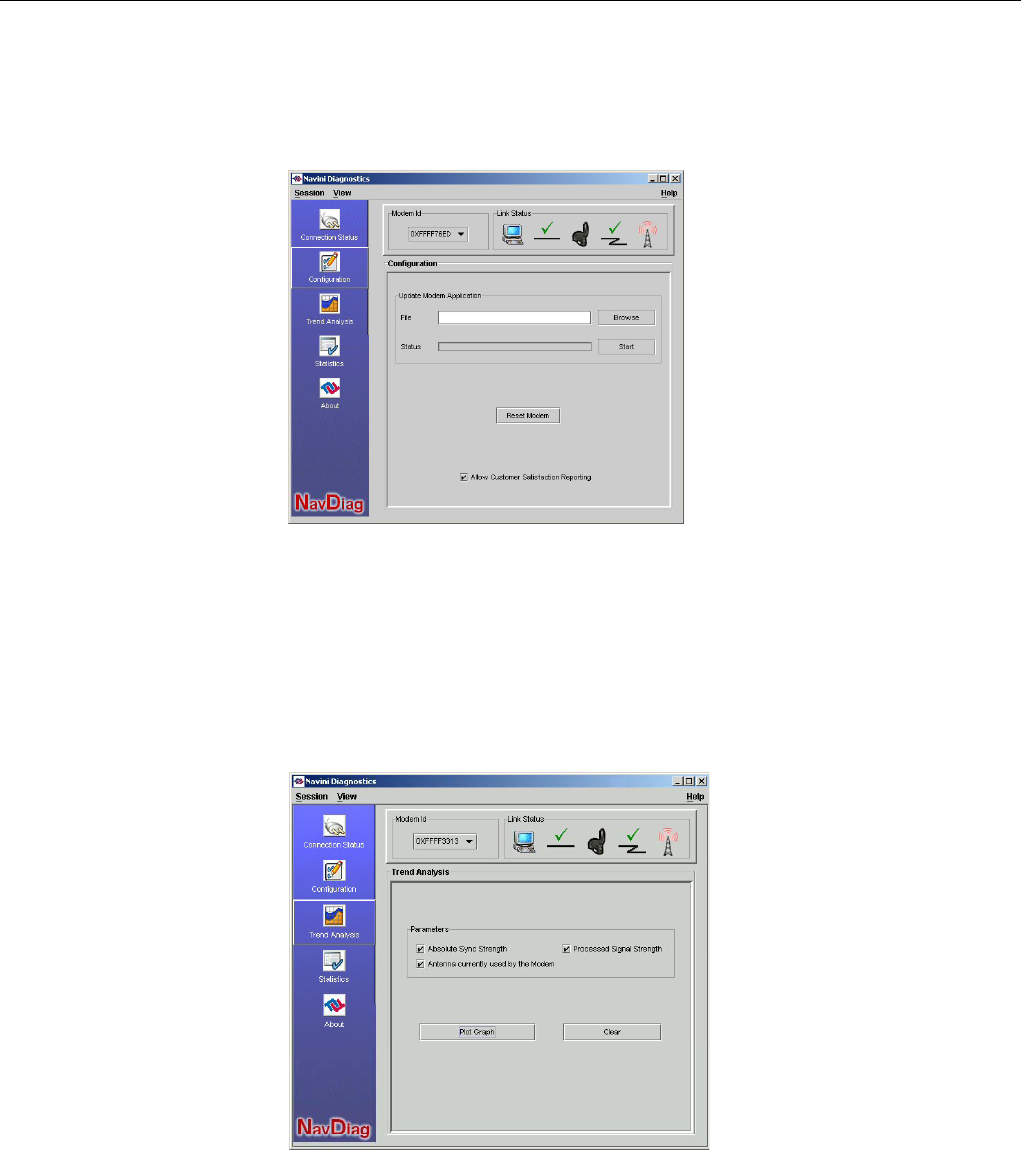
Navini Networks, Inc. Ripwave Wireless Broadband Access Card User’s Guide
Page 21
050525_pv1.2_PC_Card_User’s_Guide_40-00292-00b(4.3)
Using Navini Diagnostics,
continued
The following screen appears when you select Configuration. This
screen enables you to update your Card’s software, if directed to do
so by your Service Provider.
The “Allow Customer Satisfaction Reporting” feature is not
currently supported in the PC card.
The Trend Analysis screen enables you to view Card parameters
that evolve over time. With this screen, you can select up to three
parameters to plot.
By pressing the Plot Graph button, the following screen will
appear. This screen displays the value of the selected parameters
over the last five minutes, updated once every second. The graphic
scrolls from right to left.
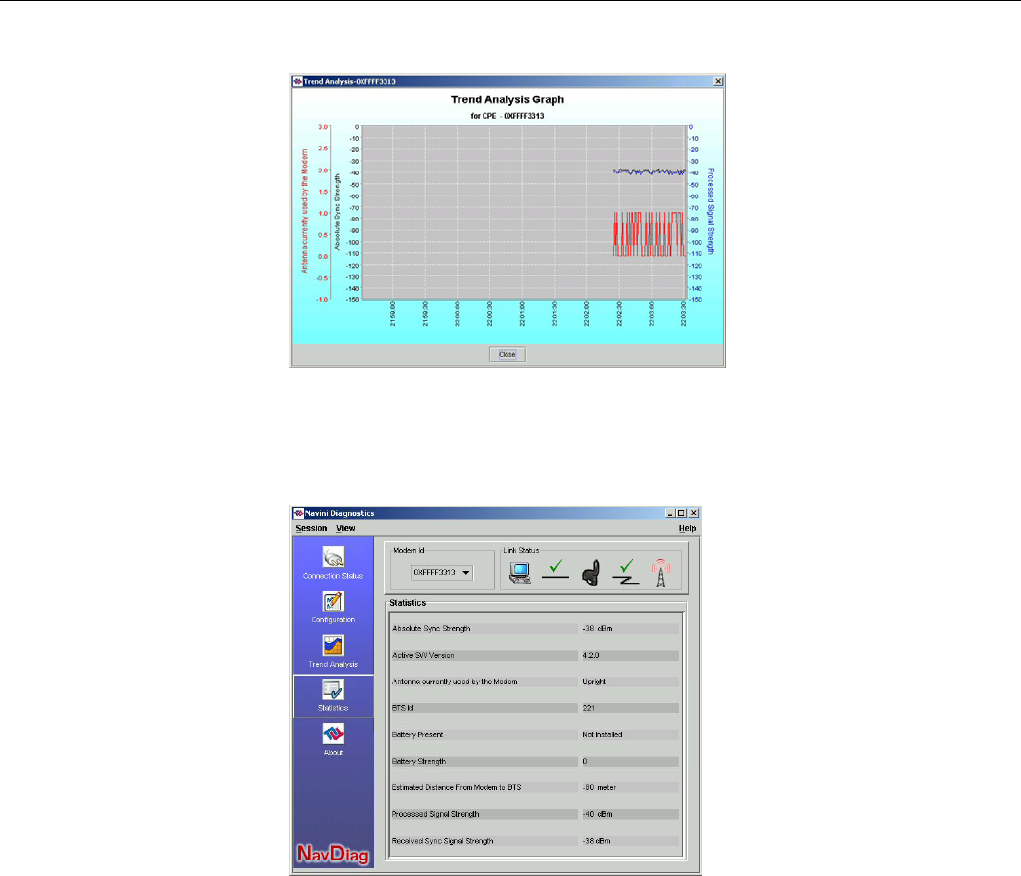
Navini Networks, Inc. Ripwave Wireless Broadband Access Card User’s Guide
Page 22
050525_pv1.2_PC_Card_User’s_Guide_40-00292-00b(4.3)
Using Navini Diagnostics,
continued
To view the Statistics screen, press the Statistics button. The
Statistics screen enables you to view the current value of selected
parameters, which are updated as they change over time.
The About screen provides vital information such as the version of
the Navini Diagnostics software currently installed on your
computer. It also provides a website address and telephone number
where you can contact your Service Provider. An example of the
About screen follows.
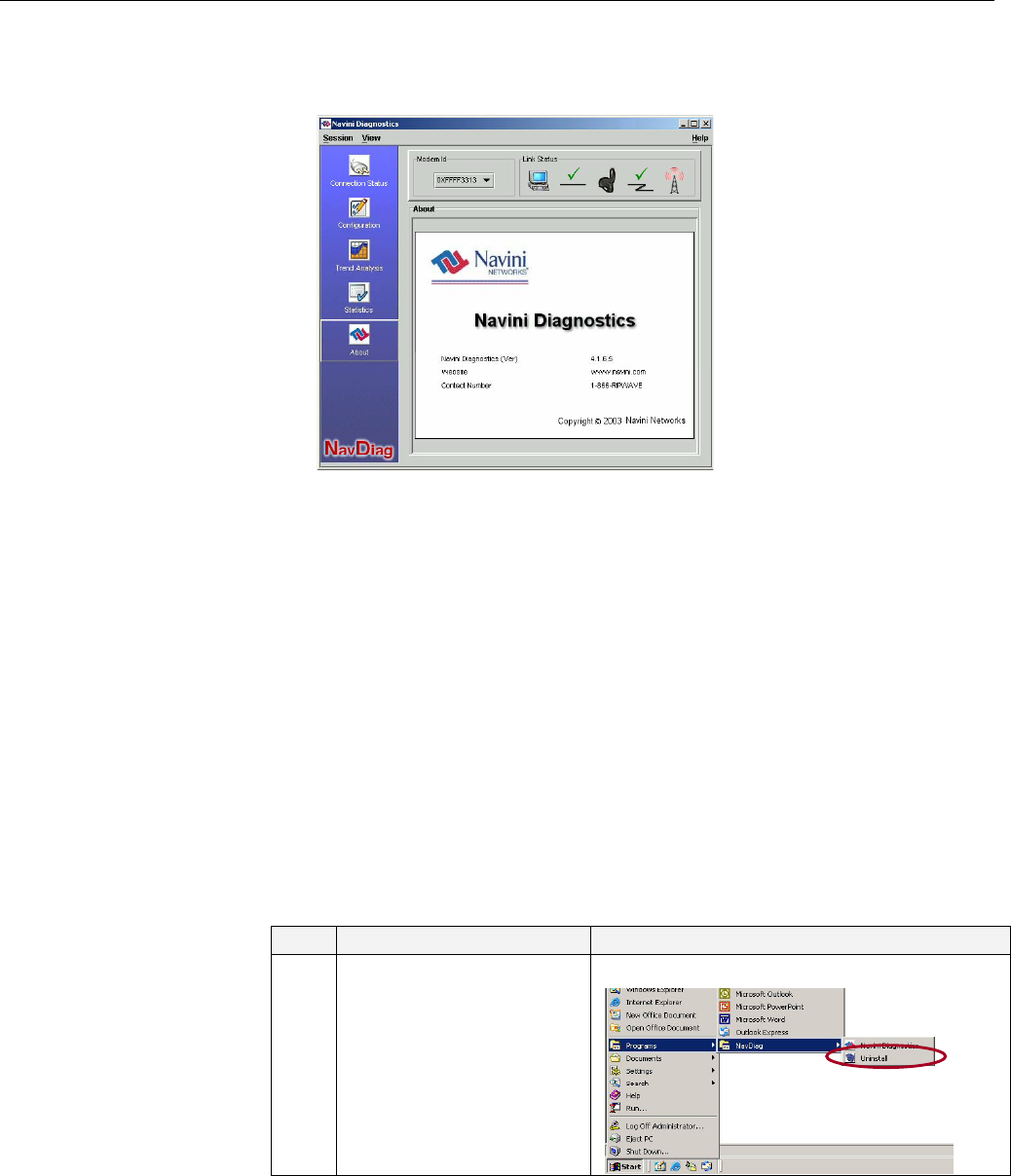
Navini Networks, Inc. Ripwave Wireless Broadband Access Card User’s Guide
Page 23
050525_pv1.2_PC_Card_User’s_Guide_40-00292-00b(4.3)
Using Navini Diagnostics,
continued
Uninstalling
Navini
Diagnostics
Software
A Help button appears on the top right corner of all the NavDiag
windows. The Help button gives you two options. The first option,
On NavDiag, provides help text on the functionality of the
NavDiag program. The second option, About NavDiag, is
equivalent to clicking on the About icon.
If for some reason you need to uninstall the NavDiag software,
e.g., to upgrade your Operating System software, follow the
procedure below.
Note: The screenshots shown in these instructions were taken from
a laptop with Windows 2000. If you have a Windows 98, XP, or
ME operating system, the screens you see may vary from the
screens shown in the instructions.
Step Action Illustration
1. On your computer
screen lower left corner,
click on Start >
Programs > NavDiag >
Uninstall.
Windows 2000 Screen
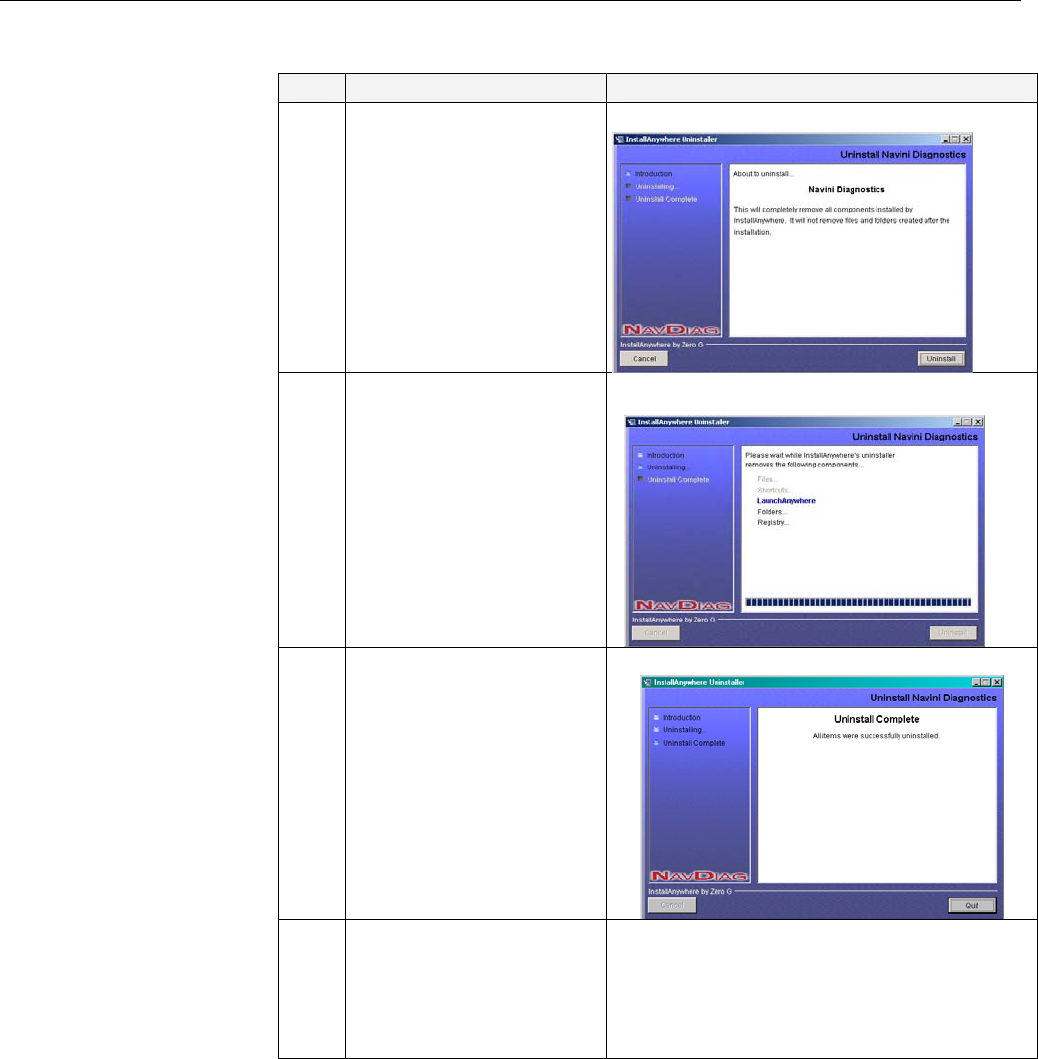
Navini Networks, Inc. Ripwave Wireless Broadband Access Card User’s Guide
Page 24
050525_pv1.2_PC_Card_User’s_Guide_40-00292-00b(4.3)
Uninstalling NavDiag
Software, continued
Optional
Desktop
Antenna
Step Action Illustration
2. The Install-Anywhere
Uninstaller screen
appears. Click
Uninstall.
Windows 2000 Screen
3. The screen will indicate
the application files are
uninstalled.
Windows 2000 Screen
4. The Uninstall Complete
screen appears when
finished. Click on Quit
to close the Uninstall
screen.
Windows 2000 Screen
5. Restart the PC to
complete the uninstall
process. This will ensure
it functions properly
after uninstalling.
An optional desktop antenna is available for the Ripwave Wireless
Broadband Access Card. This antenna connects to the PC Card and
then sits on a surface next to the laptop. This antenna should be
used if optimal reception can not be obtained through the PC Card
antenna. Following is a picture of the optional desktop antenna.

Navini Networks, Inc. Ripwave Wireless Broadband Access Card User’s Guide
Page 25
050525_pv1.2_PC_Card_User’s_Guide_40-00292-00b(4.3)
Optional Desktop Antenna,
continued
Care and
Maintenance
To connect the desktop antenna to the PC Card, you must first
remove the antenna attached to the PC Card. To remove the
antenna, grasp the base of the antenna near its connection point and
then firmly pull the antenna away from the card. Do not grasp the
top or middle of the antenna as it may break when you try to pull
the antenna away. Once the PC Card antenna is removed, connect
the desktop antenna by inserting its connector into the port on the
PC Card. If a desktop antenna is required for optimal reception,
avoid frequently connecting and disconnecting the desktop antenna
from the PC Card as frequent connection/disconnection may cause
the connector on the desktop antenna to break.
The Ripwave Wireless Broadband Access Card is designed to give
years of trouble-free service. To ensure operation, read the
following care and maintenance instructions.
Keep the PC Card free of dust and moisture. If the Card gets
wet, use a towel to dry it immediately.
Handle the PC Card gently. Dropping it or mishandling it can
cause damage to the metal/plastic shell or the electronic
circuitry.
Keep the PC Card away from high temperatures. Heat can
cause damage to the metal/plastic shell or the electronic
circuitry.
To clean the external areas of the PC Card, use only an
electrical contact cleaner that is non-conductible and a soft,
damp, lint-free cloth. Do not use any chemicals or abrasives to
clean the Card. Also use caution around the connection pins.

Navini Networks, Inc. Ripwave Wireless Broadband Access Card User’s Guide
Page 26
050525_pv1.2_PC_Card_User’s_Guide_40-00292-00b(4.3)
Care and Maintenance,
continued
Upgrading the
PC Card
If there is a problem with the Card, do not attempt to repair it
yourself. Report the problem to your Service Provider.
Do not apply adhesive labels to the Card. This may cause the
card to become jammed inside the card slot.
The PC Card should fit easily into the PC slot. Do not force the
card into the PC slot. Forcing the card into the slot may cause
damage to the connector pins.
If you are going to upgrade your computer Operating System
after loading the NavDiag software, you must first uninstall
NavDiag prior to upgrading the OS. Otherwise, NavDiag will
not work. See Uninstall instructions in this Guide.
There are two different ways to upgrade the software that makes
the PC Card work. Your Service Provider may perform an over-
the-air (OTA) upgrade, where the up-to-date software files are
transferred wirelessly from a Base Station to your Card; or the
Provider may provide a downloadable web file or CD-ROM with
software that is installed on your PC and used to upgrade the Card
software.
The latter method is used only if the PC Card was not inserted and
“on” during the OTA upgrade process. The OTA upgrade is
normally transparent to the user; in other words, there should be no
noticeable service interruption. The web or CD upgrade comes
with instructions and takes a minimal amount of time to complete.
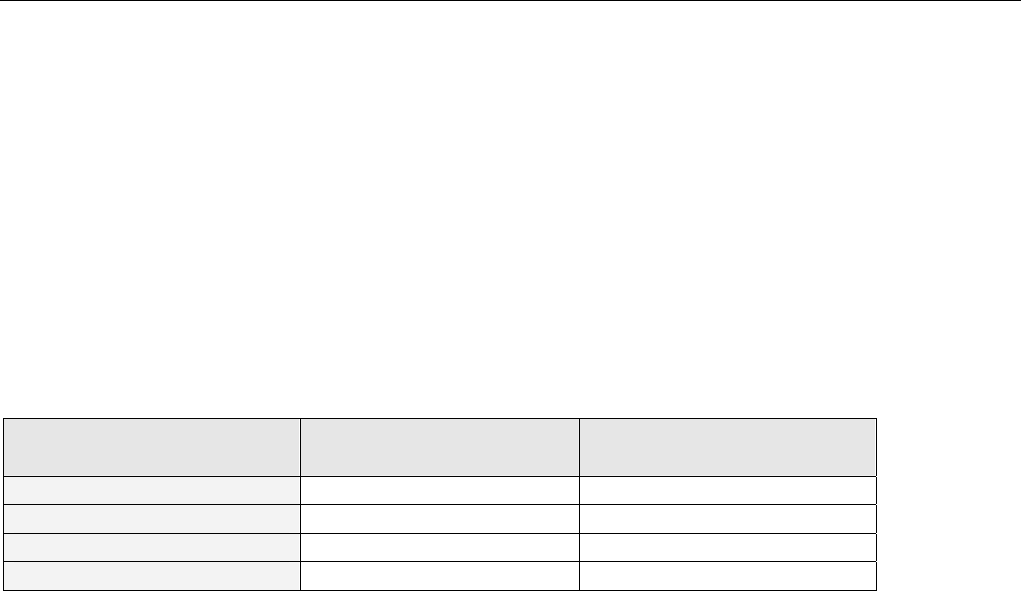
Navini Networks, Inc. Ripwave Wireless Broadband Access Card User’s Guide
Page 27
050525_pv1.2_PC_Card_User’s_Guide_40-00292-00b(4.3)
ADDENDUM 1: PC Card - PC Troubleshooting
- For Use With the Ripwave Wireless Broadband Access Card & Navini Diagnostics Software -
PC Operating Systems
Prior to installing the Navini Diagnostics (NavDiag) software, please check to ensure that the PC
Operating System meets the criteria given in the table below. If these criteria are not met,
unpredictable problems may occur as a result of installation. It is recommended that the user
have the latest Windowsc updates installed prior to installing the NavDiag software.
Operating System PC Card Interface Notes
Win98, 2nd edition Supported 1
WinME Supported 1
Win 2000 Supported 1, 3
Win XP Supported 2, 3
Note 1: Internet Explorer 3.0 or higher is required
Note 2: Requires Service Pack 1
Note 3: To load the NavDiag software, the user MUST have Administrative privileges.
Results of Correct NavDiag Installation
Experienced PC users can check the results of the Navini Diagnostics installation by looking at
the log file that is created during the installation process. The log file is named
“Ripwave_Diagnostics_InstallLog.log.” It is located under c:\Program Files\Navini
Diagnostics.
-------
Install Begin: Tue Jul 20 12:15:22 CDT 2004
Install End: Tue Jul 20 12:15:30 CDT 2004
Created with Zero G's InstallAnywhere 4.5.3 Enterprise Build 1394
Summary
-------
Installation: Successful with warnings.
2 SUCCESSES
1 WARNINGS
0 NONFATAL ERRORS
0 FATAL ERRORS
Action Notes:
None.

Navini Networks, Inc. Ripwave Wireless Broadband Access Card User’s Guide
Page 28
050525_pv1.2_PC_Card_User’s_Guide_40-00292-00b(4.3)
Install Log Detail:
Check Disk Space: C:\Program Files\NavDiag
Status: SUCCESSFUL
Additional Notes: NOTE - Required Disk Space: 29,363,315; Free Disk Space: 30,806,179,840
Install Directory: C:\Program Files\NavDiag\
Status: SUCCESSFUL
Get Registry Entry: Key: HKEY_LOCAL_MACHINE\SOFTWARE\Navini Networks\NavDiag, ValueName:
InstallDirectory
Status: WARNING
Additional Notes: WARNING - Win32Exception
Make Registry Entry: Key: HKEY_LOCAL_MACHINE\SOFTWARE\Navini Networks, Value Name: , Value
Data:
Status: SUCCESSFUL
Make Registry Entry: Key: HKEY_LOCAL_MACHINE\SOFTWARE\Navini Networks\NavDiag, Value Name:
, Value Data:
Status: SUCCESSFUL
Make Registry Entry: Key: HKEY_LOCAL_MACHINE\SOFTWARE\Navini Networks\NavDiag, Value Name:
InstallDirectory, Value Data: C:\Program Files\NavDiag
Status: SUCCESSFUL
Install Directory: C:\Program Files\NavDiag\Uninstall\
Status: SUCCESSFUL
Install Uninstaller: Navini Diagnostics (Install All Uninstaller Components)
Status: SUCCESSFUL
Install Directory: C:\Program Files\NavDiag\jre
Status: SUCCESSFUL
Install File: C:\Program Files\NavDiag\Uninstall\Uninstall NavDiag.exe
Status: SUCCESSFUL
Install File: C:\Program Files\NavDiag\Uninstall\Uninstall NavDiag.lax
Status: SUCCESSFUL
Install Directory: C:\Program Files\NavDiag\Uninstall\resource\
Status: SUCCESSFUL
Install File: C:\Program Files\NavDiag\Uninstall\resource\iawin32.dll
Status: SUCCESSFUL
Install File: C:\Program Files\NavDiag\Uninstall\resource\remove.exe
Status: SUCCESSFUL
Make Registry Entry: Key:
HKEY_LOCAL_MACHINE\SOFTWARE\Microsoft\Windows\CurrentVersion\Uninstall\Navini Diagnostics,
Value Name: DisplayName, Value Data: Navini Diagnostics

Navini Networks, Inc. Ripwave Wireless Broadband Access Card User’s Guide
Page 29
050525_pv1.2_PC_Card_User’s_Guide_40-00292-00b(4.3)
Status: SUCCESSFUL
Make Registry Entry: Key:
HKEY_LOCAL_MACHINE\SOFTWARE\Microsoft\Windows\CurrentVersion\Uninstall\Navini Diagnostics,
Value Name: UninstallString, Value Data: "C:\Program Files\NavDiag\Uninstall\Uninstall NavDiag.exe"
Status: SUCCESSFUL
Install Uninstaller: Navini Diagnostics (Install All Uninstaller Components)
Status: SUCCESSFUL
Create LaunchAnywhere: Navini Diagnostics.exe (Install All LaunchAnywhere Java Executable Components)
Status: SUCCESSFUL
Install File: C:\Program Files\NavDiag\Navini Diagnostics.exe
Status: SUCCESSFUL
Install File: C:\Program Files\NavDiag\Navini Diagnostics.lax
Status: SUCCESSFUL
Create LaunchAnywhere: Navini Diagnostics.exe (Install All LaunchAnywhere Java Executable Components)
Status: SUCCESSFUL
Install Directory: C:\Program Files\NavDiag\data\
Status: SUCCESSFUL
Install Directory: C:\Program Files\NavDiag\data\images\
Status: SUCCESSFUL
Install File: C:\Program Files\NavDiag\data\images\billboard.gif
Status: SUCCESSFUL
Install File: C:\Program Files\NavDiag\data\images\splash.gif
Status: SUCCESSFUL
Install File: C:\Program Files\NavDiag\data\images\buttonbar.gif
Status: SUCCESSFUL
Install File: C:\Program Files\NavDiag\data\images\about2.gif
Status: SUCCESSFUL
Install File: C:\Program Files\NavDiag\data\images\about1.gif
Status: SUCCESSFUL
Install File: C:\Program Files\NavDiag\data\images\about.gif
Status: SUCCESSFUL
Install File: C:\Program Files\NavDiag\data\images\uninstall.gif
Status: SUCCESSFUL
Install Directory: C:\Program Files\NavDiag\data\log\
Status: SUCCESSFUL
Install Directory: C:\Program Files\NavDiag\data\lib\
Status: SUCCESSFUL

Navini Networks, Inc. Ripwave Wireless Broadband Access Card User’s Guide
Page 30
050525_pv1.2_PC_Card_User’s_Guide_40-00292-00b(4.3)
Install File: C:\Program Files\NavDiag\data\lib\ctl.jar
Status: SUCCESSFUL
Install File: C:\Program Files\NavDiag\data\lib\navDiag.jar
Status: SUCCESSFUL
Install File: C:\Program Files\NavDiag\data\lib\jfreechart-0.9.13.jar
Status: SUCCESSFUL
Install File: C:\Program Files\NavDiag\data\lib\jcommon-0.8.8.jar
Status: SUCCESSFUL
Install File: C:\Program Files\NavDiag\data\lib\log4j.jar
Status: SUCCESSFUL
Install Directory: C:\Program Files\NavDiag\data\doc\
Status: SUCCESSFUL
Install Directory: C:\Program Files\NavDiag\config\
Status: SUCCESSFUL
Install File: C:\Program Files\NavDiag\config\NavDiag.lcf
Status: SUCCESSFUL
Install Directory: C:\Documents and Settings\luis\Start Menu\Programs\NavDiag\
Status: SUCCESSFUL
Create Shortcut: C:\Documents and Settings\luis\Start Menu\Programs\NavDiag\Navini Diagnostics.lnk
Status: SUCCESSFUL
Create Shortcut: C:\Documents and Settings\luis\Start Menu\Programs\NavDiag\Uninstall.lnk
Status: SUCCESSFUL
Install Directory: C:\Documents and Settings\luis\Desktop\
Status: SUCCESSFUL
Additional Notes: NOTE - Directory already existed
Create Shortcut: C:\Documents and Settings\luis\Desktop\Navini Diagnostics.lnk
Status: SUCCESSFUL

Navini Networks, Inc. Ripwave Wireless Broadband Access Card User’s Guide
Page 31
050525_pv1.2_PC_Card_User’s_Guide_40-00292-00b(4.3)
ADDENDUM 2: End User Software License Agreement
between
Navini Networks, Inc.
and
Buyer
ARTICLE 1
IMPORTANT MESSAGE
1.1 Act of Assent. Installing the Software indicates that you have read, understand and accept
this License Agreement.
ARTICLE 2
LICENSES
2.1 Grant of License. The Software and related Documentation, are the intellectual property
of Navini Networks, Inc. and are protected by law. Navini Networks, Inc. grants to
Buyer a personal, nonexclusive, nontransferable worldwide license, for revocable use (as
permitted herein) of the Software based on the terms and conditions of this License
Agreement and the Master Supply Agreement to which it is attached. Buyer is permitted
to install and use the Software on its server, but only in conjunction with the Navini
Hardware. Buyer is not permitted to rent, sell or otherwise transfer the Software to any
third parties.
2.2 Ownership Rights. Under this Agreement, Buyer does not acquire any rights of
ownership in the Software and related Documentation and subsequent releases and
versions licensed by Navini Networks, Inc. to Buyer pursuant to this License Agreement,
whether in printed or machine-readable format. Buyer acquires only the right to use the
Software and related Documentation subject to the terms and conditions of this
Agreement. Buyer promises to keep the Software in confidence for the benefit of Navini
Networks, Inc. and agrees to destroy or return the Software and all copies at such time as
Buyer chooses to cease using the Software or upon termination or cancellation of this
License Agreement for any reason.
2.3 Backup Copies. Buyer may copy the Software for safekeeping (archival) or backup
purposes, provided that all such copies of the Software are subject to the provisions of
this License Agreement, and also provided that each copy shall include in readable
format any and all confidential, proprietary, and copyright notices or markings contained
in the original.
2.4 Assignment. The rights granted in this License Agreement are restricted for use solely by
Buyer and may not be assigned, transferred, or sublicensed, however Buyer may grant
access to its server to End-Users. Each Buyer shall be authorized to make use of the
Software in the form in which it is provided to Buyer solely for Buyer’s own computer
server location. Buyer represents that it will not use the Software for any purpose that is
not expressly delineated in this Agreement. Further Buyer represents that it will comply
with all export, re-export, and other laws in its use of the Software.

Navini Networks, Inc. Ripwave Wireless Broadband Access Card User’s Guide
Page 32
050525_pv1.2_PC_Card_User’s_Guide_40-00292-00b(4.3)
2.5 Suitability.
a. Buyer alone is responsible for determining which software best suits Buyer’s
needs, for installing and operating the Software, and for the results obtained.
Accordingly, each Buyer should determine its needs, and evaluate the Software’s
capabilities before making a final decision about licensing the software.
b. Navini Networks, Inc. makes no representation that the Software conforms to or
satisfies any federal, state, or local laws. Buyer is encouraged to engage
professional assistance from attorneys and engineers to evaluate the suitability of
the Software for Buyer’s use.
c. Navini Networks, Inc. makes no claims that the Software is suitable for Buyer’s
intended purposes.
2.6 Remote Digital Access. Navini Networks, Inc. reserves the right, but is not obligated to
digitally access the Software for the purposes of upgrading and maintaining the Software.
2.7 U.S. GOVERNMENT RESTRICTED RIGHTS. All Software provided to the U.S.
Government pursuant to solicitations issued on or after December 1, 1995 is provided
with the commercial license rights and restrictions described elsewhere herein. All
Software provided to the U.S. Government pursuant to solicitations issued prior to
December 1, 1995 is provided with “Restricted Rights” as provided for in FAR, 48 CFR
52.227-14 (June 1987) or DFAR, 48 CFR 252.227-7013 (Oct 1988), as applicable
ARTICLE 3
TRADE SECRETS
3.1 Trade Secret. Navini Networks, Inc. considers the licensed Software covered by this
License Agreement to be a trade secret. Navini Networks, Inc. does not disclose any
information to Navini Networks, Inc. competitors or potential competitors. Buyer shall
not disclose any design, code, or technological know-how gained by access to the
Software to Licensor’s competitors. Buyer shall not use design, code, or documentation
gained by access to the Software to develop a similar technology or a competing software
product. To attempt to or to do so, the Parties acknowledge, understand and agree,
constitute a material breach of this License Agreement.
3.2 Third Party Intellectual Property. Buyer acknowledges, understands and agrees that the
licensed Software covered by this License Agreement may contain Intellectual Property
owned by Third Parties and duly licensed to Navini Networks, Inc. Copyright, Patent
and other laws protect Third Party Intellectual Property manufactured with, marketed
with, or otherwise bundled with the licensed Software. Buyer promises to keep such
Third Party Intellectual Property in confidence to the benefit of the Third Party, agrees
not to reverse engineer or otherwise decompile Third Party Intellectual Property, and
agrees to stop using, destroy and/or return such Third Party owned Intellectual Property
under the same terms and conditions as the licensed Software as set forth in this License
Agreement.

Navini Networks, Inc. Ripwave Wireless Broadband Access Card User’s Guide
Page 33
050525_pv1.2_PC_Card_User’s_Guide_40-00292-00b(4.3)
ARTICLE 4
INDEMNIFICATIONS AND WARRANTY
4.1 Intellectual Property Indemnification; Entire Liability. ARTICLE 15 OF THE SUPPLY
AGREEMENT TO WHICH THIS AGREEMENT IS ATTACHED STATES THE
ENTIRE LIABILITY OF NAVINI NETWORKS, INC. WITH RESPECT TO
INFRINGEMENT OF COPYRIGHTS, TRADE SECRETS, TRADEMARKS,
PATENTS, AND OTHER INTELLECTUAL PROPERTY RIGHTS BY THE
LICENSED SOFTWARE, DOCUMENTATION, OR ANY PARTS THEREOF, AND
NAVINI NETWORKS, INC. SHALL HAVE NO ADDITIONAL LIABILITY WITH
RESPECT TO ANY ALLEGED OR PROVEN INFRINGEMENT.
4.2 Warranty. EXCEPT AS GRANTED IN THE BODY OF THE SUPPLY AGREEMENT
TO WHICH THIS LICENSE AGREEMENT IS ATTACHED, THE LICENSED
SOFTWARE IS PROVIDED BY NAVINI NETWORKS, INC. “AS IS” AND
WITHOUT WARRANTY OF ANY KIND OR NATURE, WRITTEN OR ORAL,
EXPRESS OR IMPLIED, INCLUDING (WITHOUT LIMITATION) THE IMPLIED
WARRANTIES OF MERCHANTABILITY AND FITNESS FOR A PARTICULAR
PURPOSE. THIS LIMITATION OF WARRANTIES WAS A MATERIAL FACTOR
IN THE ESTABLISHMENT OF THE LICENSE FEE CHARGED FOR EACH
SPECIFIC ITEM OF SOFTWARE LICENSED.
ARTICLE 5
LIMITATION OF LIABILITY
5.1 Consequential Damages. TO THE MAXIMUM EXTENT PERMITTED BY THE
APPLICABLE LAW, IN NO EVENT SHALL NAVINI NETWORKS, INC. OR ANY
THIRD PARTY INVOLVED IN THE CREATION, PRODUCTION, DELIVERY, OR
LICENSING OF THE SOFTWARE BE LIABLE FOR ANY LOST REVENUES,
PROFITS OR DATA OR OTHER SPECIAL, INDIRECT, INCIDENTAL,
CONSEQUENTIAL, OR PUNITIVE DAMAGES, HOWEVER CAUSED AND
REGARDLESS OF THEORY OF LIABILITY, EVEN IF NAVINI NETWORKS, INC.
HAS, OR SHOULD HAVE HAD ANY KNOWLEDGE, ACTUAL OR
CONSTRUCTIVE, OF THE POSSIBILITY OF SUCH DAMAGES.
5.2 License-Fee Limitation. Except for the indemnification provisions of Article 15, Navini
Networks, Inc.’s maximum liability for damages is limited to the license fees paid by
Buyer under this Agreement for the particular licensed Software that caused the damages.
5.3 Loss of Data. Software error can cause a significant loss of data. Navini Networks, Inc.
shall not be responsible for any loss of data. Navini Networks, Inc.’s responsibility is to
correct the Software error as provided in this License Agreement or the Supply
Agreement to which it is attached. It is Licensee’s responsibility to have adequate
backup procedures to protect Buyer from significant loss of valid data.

Navini Networks, Inc. Ripwave Wireless Broadband Access Card User’s Guide
Page 34
050525_pv1.2_PC_Card_User’s_Guide_40-00292-00b(4.3)
ARTICLE 6
OBJECT CODE ONLY-NO MODIFICATIONS
6.1 Modifications. In order to maintain the “trade secret” status of the information contained
in the Licensed Software, Navini Networks, Inc. provides the Software in object-code
form only. Buyer shall not modify, enhance, adapt, disassemble, translate, decompile or
otherwise decode any portion of the object code of the Software module. Buyer shall not
use the Software without a license to the Software object code. The object code contains
the license number, date of license, and other license information. This information is
placed in the object-code portions to prevent unauthorized and unlicensed distributions of
the Software. Buyer shall not subvert or change any of this information. Further Buyer
shall not make, full or partial, copies of any documentation whether printed or machine-
readable media supplied with the Licensed Software unless expressly granted prior
written permission by Navini Networks, Inc.
6.2 Responsibility for Damages. Buyer is subject to the provisions of the Supply Agreement
with respect to the Software (including Section 16). Buyer is fully liable and responsible
for any damages, indirect or direct, and costs that Navini Networks, Inc. may incur if
Buyer appoints a subcontractor who accesses the Software without Navini’s prior written
consent. Buyer shall defend, indemnify, and hold Navini Networks, Inc., its directors,
officers, employees, agents, Authorized Partners, and other representatives harmless
accordingly for all costs and direct and indirect damages sustained by Navini Networks,
Inc. However, if the subcontractor is pre-approved by Navini in writing for access to the
Software, then this Section shall not apply.
6.3 Copyright Notices. Buyer shall not remove any copyright or proprietary rights notice or
identification that indicates Navini Networks, Inc. ownership from any part of the
licensed Software, it being expressly understood and agreed that the existence of such
copyright notice should not be construed as an admission or presumption that publication
of the licensed Software has occurred.
END OF AGREEMENT
Copyright © 2004-2005 Navini Networks, Inc.
All rights reserved. Printed in the USA.
Navini Networks is a registered trademark. Zero-Install, Ripwave, and Unwired by Navini are
trademarks of Navini Networks, Inc. Other product and company names mentioned herein may
be trademarks and/or service marks of their respective owners. Rev. 052302